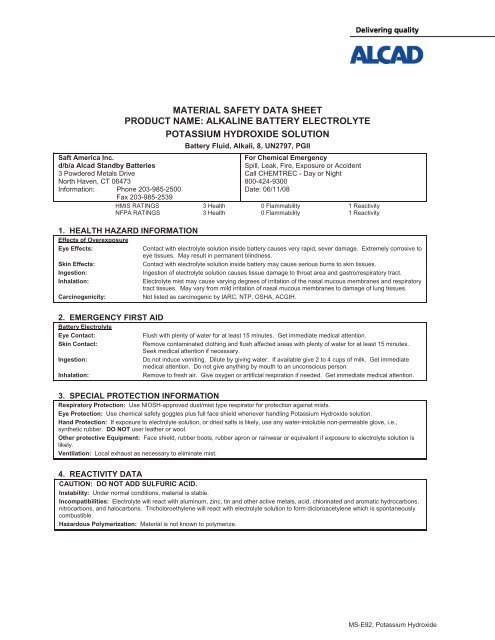Print MSDS - Miller Electric Company Publications
Print MSDS - Miller Electric Company Publications
Print MSDS - Miller Electric Company Publications
Create successful ePaper yourself
Turn your PDF publications into a flip-book with our unique Google optimized e-Paper software.
Saft America Inc.<br />
d/b/a Alcad Standby Batteries<br />
3 Powdered Metals Drive<br />
North Haven, CT 06473<br />
Information: Phone 203-985-2500<br />
Fax 203-985-2539<br />
MATERIAL SAFETY DATA SHEET<br />
PRODUCT NAME: ALKALINE BATTERY ELECTROLYTE<br />
POTASSIUM HYDROXIDE SOLUTION<br />
Battery Fluid, Alkali, 8, UN2797, PGII<br />
For Chemical Emergency<br />
Spill, Leak, Fire, Exposure or Accident<br />
Call CHEMTREC - Day or Night<br />
800-424-9300<br />
Date: 06/11/08<br />
HMIS RATINGS 3 Health 0 Flammability 1 Reactivity<br />
NFPA RATINGS 3 Health 0 Flammability 1 Reactivity<br />
1. HEALTH HAZARD INFORMATION<br />
Effects of Overexposure<br />
Eye Effects: Contact with electrolyte solution inside battery causes very rapid, sever damage. Extremely corrosive to<br />
eye tissues. May result in permanent blindness.<br />
Skin Effects: Contact with electrolyte solution inside battery may cause serious burns to skin tissues.<br />
Ingestion: Ingestion of electrolyte solution causes tissue damage to throat area and gastro/respiratory tract.<br />
Inhalation: Electrolyte mist may cause varying degrees of irritation of the nasal mucous membranes and respiratory<br />
tract tissues. May vary from mild irritation of nasal mucous membranes to damage of lung tissues.<br />
Carcinogenicity: Not listed as carcinogenic by IARC, NTP, OSHA, ACGIH.<br />
2. EMERGENCY FIRST AID<br />
Battery Electrolyte<br />
Eye Contact: Flush with plenty of water for at least 15 minutes. Get immediate medical attention.<br />
Skin Contact: Remove contaminated clothing and flush affected areas with plenty of water for at least 15 minutes.<br />
Seek medical attention if necessary.<br />
Ingestion: Do not induce vomiting. Dilute by giving water. If available give 2 to 4 cups of milk. Get immediate<br />
medical attention. Do not give anything by mouth to an unconscious person.<br />
Inhalation: Remove to fresh air. Give oxygen or artificial respiration if needed. Get immediate medical attention.<br />
3. SPECIAL PROTECTION INFORMATION<br />
Respiratory Protection: Use NIOSH-approved dust/mist type respirator for protection against mists.<br />
Eye Protection: Use chemical safety goggles plus full face shield whenever handling Potassium Hydroxide solution.<br />
Hand Protection: If exposure to electrolyte solution, or dried salts is likely, use any water-insoluble non-permeable glove, i.e.,<br />
synthetic rubber. DO NOT user leather or wool.<br />
Other protective Equipment: Face shield, rubber boots, rubber apron or rainwear or equivalent if exposure to electrolyte solution is<br />
likely.<br />
Ventilation: Local exhaust as necessary to eliminate mist.<br />
4. REACTIVITY DATA<br />
CAUTION: DO NOT ADD SULFURIC ACID.<br />
Instability: Under normal conditions, material is stable.<br />
Incompatibilities: Electrolyte will react with aluminum, zinc, tin and other active metals, acid, chlorinated and aromatic hydrocarbons,<br />
nitrocarbons, and halocarbons. Tricholoroethylene will react with electrolyte solution to form dicloroacetylene which is spontaneously<br />
combustible.<br />
Hazardous Polymerization: Material is not known to polymerize.<br />
MS-E92, Potassium Hydroxide



